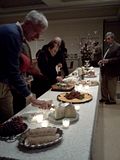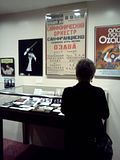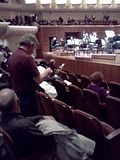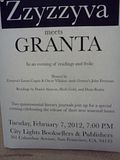On Sunday afternoon I saw the last of 3 sold-out performances by
Ensemble Parallèle of John Harbison's opera of
The Great Gatsby. The opera was performed in a slightly cut version & in a reorchestration that preserves the sonorities of a large orchestra using only about 30 musicians. Harbison's score is complex & modern-sounding. Conductor
Nicole Paiement & her band were kept busy every moment. The substantial overture establishes the opera's leitmotifs & its urgent yet often somber mood. I liked hearing the banjo that accompanies Harbison's authentic-sounding recreations of 1920s jazz. The opera condenses the novel into 11 short scenes occurring in various locations. Though the music is continuous, there are arias, duets & ensembles woven into the flow. At dramatic moments the orchestra drops out completely, leaving us with the voices alone.
The casting was excellent & the acting so good that I sometimes felt I was watching a play. Tenor
Daniel Snyder has a strong, muscular voice & was an angry Tom Buchanan. Mr. Snyder even looked like an ex-football player. Soprano
Susannah Biller has a high, solid voice, & her Daisy was outwardly confident yet easily swayed. Mezzo
Julienne Walker looked convincing as the athlete Jordan Baker, & her robust sound was a good match for Ms. Biller's in their duets. Tenor
Marco Panuccio as Gatsby has a lyrical sound, though the role's very high music was clearly challenging. I liked his acting. He was suave, a bit shady, & desperately insecure. Bass
Bojan Knezevic & mezzo
Erin Neff gave powerful, dramatic performances as the unhappy George & Myrtle Wilson. Their scenes had so much raw emotion that they did not seem like secondary characters.
Front & rear video projections enhanced the production without overdoing it. Rippling water appears out the windows of the Buchanans' home, & reflections from a swimming pool dreamily wash over Gatsby's home. The eyes of the iconic eyeglasses billboard are alive, & they watch & then entrap George & Myrtle. A procenium-filling video illustrates the tense car journey to New York. The party scenes were lively & included dancers & an on-stage band with singers. I liked the crooning of jazz singer
Mark Robinson. The many scene transitions were smooth, though it was a mistake for Gatsby to get up after being shot & then climb into his coffin. In the opera's final moments, Daisy's green light descends into the auditorium above the audiences' heads.
Composers
John Harbison &
Jacques Desjardins took a curtain call standing side-by-side. Immediately following the performance, director
Brian Staufenbiel, assisted by cast principals, ran the Gatsby raffle drawing from the stage. The performance began Bayreuth-style, with the conductor stealing into the pit after the lights went down.
§ The Great Gatsby Opera By John Harbison
World Premier Chamber Orchestration By Jacques Desjardins
Ensemble Parallèle Opera
Nicole Paiement, Conductor
Brian Staufenbiel, Director
Susannah Biller, Daisy Buchanan
Julienne Walker, Jordan Baker
Jason Detwiler, Nick Carraway
Daniel Snyder, Tom Buchanan
Bojan Knezevic, George Wilson
Erin Neff, Myrtle Wilson
Marco Panuccio, Jay Gatsby
Mark Robinson, Radio / Band Singer
Carrie Zhang, Tango Singer
Roger Mccracken Meyer Wolfsheim
John Minagro, Henry Gatz
Roy Eikleberry, The Minister
Matthew Antaky, Scenic & Lighting Designer
Christine Cook, Costumer
Austin Forbord, Videographer
Jeanna Parham, Wig & Makeup Designer
Tom Seagl, Choreographer
Novellus Theatre, Yerba Buena Center for the Arts
Sunday, February 12, 2012 – 2:00 PM
§ Photo Credit: Susannah Biller and Marco Panuccio by Steve DiBartolomeo
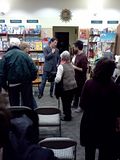 Monday night, about 50 people showed up at Books Inc. in the Marina to hear sociologist Eric Klinenberg talk about Going Solo, his new book about the rise of living alone. 40% of San Francisco households are one-person households, but this is low compared to trends in Europe & Japan. Mr. Klinenberg called this the biggest social change in the past 60 years that we have failed to identify. He told us that he originally titled the book "Alone in America," but what he learned while researching it really changed his mind about the topic. He repeatedly heard from research subjects that being lonely & alone was preferable to being lonely while in a relationship.
Monday night, about 50 people showed up at Books Inc. in the Marina to hear sociologist Eric Klinenberg talk about Going Solo, his new book about the rise of living alone. 40% of San Francisco households are one-person households, but this is low compared to trends in Europe & Japan. Mr. Klinenberg called this the biggest social change in the past 60 years that we have failed to identify. He told us that he originally titled the book "Alone in America," but what he learned while researching it really changed his mind about the topic. He repeatedly heard from research subjects that being lonely & alone was preferable to being lonely while in a relationship.

















